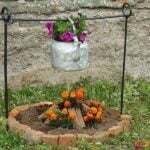Retaining wall gardening ideas have become increasingly popular among homeowners looking to maximize their outdoor spaces. Whether you have a small backyard or a sloping terrain, creating a garden on a retaining wall can add beauty and functionality to your landscape. In this article, we will explore the various aspects of retaining wall gardens, from choosing the right plants to building and maintaining a strong wall for your garden.
One of the key advantages of retaining wall gardening is the ability to transform an otherwise unused space into a lush and vibrant garden. The vertical nature of retaining walls provides an opportunity to create multi-level gardens, making it possible to grow a variety of plants while maximizing space. Additionally, these gardens can help prevent soil erosion and water runoff, making them not only visually appealing but also beneficial for the environment.
When it comes to choosing plants for your retaining wall garden, it is important to consider the specific conditions of your location. Factors such as sunlight exposure, soil type, and climate will all play a role in determining which plants will thrive in your garden. By selecting the right combination of flowers, herbs, and vegetables, you can create a beautiful and functional garden that suits your individual needs and preferences.
Benefits of Retaining Wall Gardening
Retaining walls are not just structural elements that hold back soil and prevent erosion – they can also provide a unique opportunity for creating stunning and functional gardens. When it comes to retaining wall gardening, there are numerous benefits that go beyond simply adding aesthetic appeal to your outdoor space.
Enhanced Visual Appeal
One of the key benefits of retaining wall gardening is the ability to add depth and interest to your landscape. By tiering plants at different levels on the retaining wall, you can create an eye-catching display that adds texture and color to your garden. This vertical arrangement also allows you to showcase a wider variety of plants in a smaller space, making it perfect for those with limited yard space.
Erosion Control
Retaining walls serve a practical purpose in controlling soil erosion, especially on sloped landscapes. By incorporating a garden into your retaining wall design, you not only prevent soil from washing away but also help absorb excess water and reduce runoff. This can be particularly beneficial in areas prone to heavy rainfall or where soil erosion is a concern.
Increased Gardening Space
For urban dwellers or those with small yards, retaining wall gardening offers a creative solution for maximizing gardening space. Instead of being limited by flat ground, you can utilize vertical space on the retaining wall to grow a wide range of plants.
This opens up opportunities for growing herbs, flowers, vegetables, and even dwarf fruit trees in spaces where traditional gardening may not be feasible. By thinking outside the box and utilizing every available inch of your outdoor area, you can create a lush and thriving garden that enhances your home’s exterior.
Choosing the Right Plants for Your Retaining Wall Garden
When it comes to choosing the right plants for your retaining wall garden, it is essential to consider various factors such as sunlight exposure, soil quality, and maintenance requirements. Selecting the appropriate plants can not only enhance the visual appeal of your garden but also contribute to its overall health and vitality. Here are some tips to help you make the best plant choices for your retaining wall garden:
- Consider the microclimate of your garden: Different areas of your retaining wall may receive varying amounts of sunlight and moisture. Choose plants that thrive in specific conditions based on these factors.
- Opt for low-maintenance plants: To minimize the time and effort required to care for your garden, select plants that are well-suited to your climate and soil type. Drought-resistant or native plants are excellent choices for retaining wall gardens.
- Think about plant size and growth habits: Since space may be limited in a retaining wall garden, choose plants that will not outgrow their designated area or require frequent pruning. Consider using cascading or trailing plants to add depth and dimension to vertical spaces.
When planning the plant selection for your retaining wall garden, keep in mind that variety is key to creating an interesting and dynamic landscape. Combining different colors, textures, and heights can result in a visually appealing design that complements the structural elements of your retaining wall. By carefully selecting plants that are well-suited to your garden’s environment and aesthetic goals, you can create a stunning display that showcases the beauty of nature within a vertical space.
It is also important to consider how plant roots will interact with the structure of your retaining wall. Opt for shallow-rooted species or use planting techniques that prevent root intrusion into the wall itself.
Additionally, incorporating mulch or ground cover plants can help regulate soil temperature, retain moisture, and reduce erosion along the base of the retaining wall. With thoughtful planning and strategic plant selection, you can create a thriving and sustainable garden on your retaining wall that adds beauty and charm to your outdoor space.
Design Tips for Maximizing Space in Retaining Wall Gardens
When it comes to retaining wall gardening, maximizing space is key to creating a visually appealing and functional outdoor oasis. By utilizing vertical space effectively, you can transform a simple retaining wall into a lush garden bursting with life. Here are some design tips to help you make the most of your retaining wall garden:
- Utilize tiered planting: Create multiple levels on your retaining wall by adding tiered planters or shelves. This not only adds visual interest but also allows you to grow a variety of plants in different sections.
- Choose compact and trailing plants: Opt for plants that don’t require much horizontal space and instead grow vertically or spill over the edges of the retaining wall. This will help maximize space while adding texture and depth to your garden.
- Use hanging planters or vertical gardens: Hanging planters or vertical gardening systems can be attached directly to the retaining wall, allowing you to add more greenery without taking up valuable ground space.
Incorporating these design elements will not only make your retaining wall garden more visually appealing but also create a thriving environment for your plants to flourish. Whether you have a small backyard or a large outdoor area, maximizing space in your retaining wall garden is essential for creating a beautiful and functional outdoor retreat.
Remember, creativity is key when it comes to designing your retaining wall garden. Experiment with different plant combinations, colors, and textures to find the perfect balance that suits your aesthetic preferences. With these design tips in mind, you can elevate your outdoor space with a stunning and innovative retaining wall garden that will be the envy of all your neighbors.
Building and Maintaining a Strong Retaining Wall for Your Garden
Retaining walls serve an essential function in supporting soil and preventing erosion in gardens, especially on sloped terrain. When planning a retaining wall for your garden, it is crucial to consider not only the aesthetic appeal but also the structural integrity. The key to building a strong retaining wall lies in proper construction techniques, suitable materials, and regular maintenance practices.
Choosing the Right Materials
One of the critical factors in building a durable retaining wall is selecting the right materials. Depending on your budget and preferences, options range from natural stone and concrete blocks to timber and bricks. Each material has its advantages and limitations, so it is essential to weigh factors like cost, appearance, longevity, and maintenance requirements before making a decision. Consult with a landscaping professional or garden center to determine which material best suits your needs.
Proper Drainage System
To ensure the longevity of your retaining wall, proper drainage is crucial. Without adequate drainage, water can build up behind the wall, causing pressure that may eventually lead to failure. Incorporating drainage features such as weep holes, gravel backfill, and perforated pipes can help channel water away from the structure. Regularly inspecting these drainage elements and maintaining them will prevent water-related issues that could compromise the integrity of your retaining wall over time.
Maintaining Your Retaining Wall
Regular maintenance is key to preserving the strength and appearance of your retaining wall. Inspect the structure periodically for signs of damage such as cracks, bulging, or leaning. Address any issues promptly by repairing damaged sections or replacing deteriorating materials. Additionally, keeping vegetation trimmed away from the wall can prevent roots from compromising its stability. By investing time in routine upkeep, you can ensure that your retaining wall continues to provide support for your garden for years to come.
By following these guidelines for building and maintaining a strong retaining wall for your garden and choosing suitable materials with proper drainage features will help create a lasting structure that enhances both the functionality and aesthetics of your outdoor space.
Creative Vertical Gardening Ideas for Retaining Walls
Retaining wall gardening offers a unique opportunity to create a beautiful and functional outdoor space, especially when incorporating creative vertical gardening ideas. One innovative way to make the most of your retaining wall garden is by utilizing vertical planters or hanging pots.
By arranging plants in this manner, you can take advantage of limited space while adding visual interest to your garden design. Consider mixing different types of plants with varying heights and textures to create a dynamic and eye-catching display.
Another way to elevate your retaining wall garden is by incorporating a living wall feature. Living walls are vertical gardens that are densely packed with plants, providing not only a stunning visual element but also numerous environmental benefits. These green walls help improve air quality, reduce noise pollution, and provide insulation for buildings. With the proper irrigation system in place, living walls can thrive on retaining walls, adding a touch of natural beauty to any outdoor area.
In addition to traditional planters and living walls, consider thinking outside the box when it comes to retaining wall gardening ideas. For example, you can use salvaged materials like pallets or old crates to create unique vertical gardens.
Vertical succulent gardens or herb spirals are other creative options worth exploring. The key is to let your imagination run wild and experiment with different arrangements until you find the perfect balance of plants and design elements that suit your style and space constraints for a truly unique and inspiring retaining wall garden.
Incorporating Water Features and Lighting in Retaining Wall Gardens
Water features and lighting can add a touch of tranquility and ambiance to your retaining wall garden. Incorporating these elements not only enhances the aesthetic appeal but also creates a relaxing atmosphere for you to enjoy. When it comes to water features, options such as fountains, ponds, or even simple cascading waterfalls can be integrated into the design of your retaining wall. These features not only provide visual interest but also attract birds and beneficial insects to your garden.
Adding lighting to your retaining wall garden can extend its usability well into the evening hours. Whether you choose soft uplighting to highlight specific plants or path lights to illuminate walkways, the right lighting can create a dramatic effect in your outdoor space. Solar-powered lights are a great eco-friendly option that can be easily installed without the need for electrical wiring.
Incorporating both water features and lighting in your retaining wall garden requires careful planning. Consider the overall layout of your garden, the positioning of plants, and how different elements will interact with each other. By strategically placing water features and lighting fixtures, you can create a harmonious balance that enhances the beauty and functionality of your space.
| Water Features | Lighting |
|---|---|
| Fountains | Uplighting |
| Ponds | Path Lights |
| Cascading Waterfalls | Solar-powered Lights |
Tips for Success in Retaining Wall Gardening
Retaining wall gardening can be a beautiful and practical way to maximize your outdoor space, especially in areas with sloping landscapes. To ensure the success of your retaining wall garden, there are some key tips to keep in mind.
First and foremost, it is important to carefully consider the structural integrity of the retaining wall itself. Make sure that the materials used are durable and can withstand the weight of the soil and plants. Proper drainage is also essential to prevent water buildup behind the wall, which could compromise its stability over time. Regular inspections and maintenance will help ensure that your retaining wall remains strong and secure for years to come.
When selecting plants for your retaining wall garden, choose varieties that are well-suited to the specific growing conditions of your location. Consider factors such as sunlight exposure, soil quality, and moisture levels when making your selections. Opt for plants with shallow root systems that can thrive in the limited space provided by a retaining wall. Additionally, mix and match different types of plants to create visual interest and diversity in your garden design.
Incorporating creative design elements such as trellises, hanging baskets, or vertical planters can help you make the most of your vertical space in a retaining wall garden. These features not only add aesthetic appeal but also increase planting opportunities for a greater variety of plant species.
Don’t be afraid to think outside the box and experiment with different arrangements to create a unique and striking look for your retaining wall garden. By following these tips, you can create a successful and visually stunning garden that enhances both the beauty and functionality of your outdoor living space.
Inspiration and Ideas for Unique Retaining Wall Garden Designs
When it comes to creating a unique and eye-catching retaining wall garden design, the possibilities are endless. One creative idea is to incorporate planters or shelves directly into the retaining wall itself. This not only adds visual interest but also maximizes space for planting a variety of flowers, herbs, or succulents. By integrating planters seamlessly into the structure of the retaining wall, you can create a cohesive and harmonious look that enhances your outdoor space.
Another innovative approach to designing a retaining wall garden is to use different materials and textures for added visual appeal. For example, combining natural stone with wood or metal accents can create a striking contrast that adds depth and character to your garden.
Incorporating vertical elements such as trellises or arches can also help break up the space and add dimension to your design. By mixing materials and incorporating vertical elements, you can create a dynamic and visually interesting retaining wall garden that stands out from traditional designs.
Additionally, consider adding unique features such as built-in seating areas, waterfalls, or fire pits to further enhance your retaining wall garden design. These additions not only provide functionality but also create a sense of relaxation and tranquility in your outdoor space. By thinking outside the box and incorporating creative elements into your retaining wall garden design, you can transform your backyard into a captivating oasis that reflects your personal style and creativity.
Conclusion
Retaining wall gardens offer a unique and creative way to enhance the beauty of your outdoor space. By utilizing vertical space, these gardens not only add greenery to your environment but also provide a practical solution for landscaping on sloped terrains. The benefits of retaining wall gardening are vast, from preventing erosion to creating a visually stunning focal point in your yard.
When selecting plants for your retaining wall garden, consider factors such as sunlight exposure, soil quality, and water drainage. By choosing the right plants, you can ensure a thriving and harmonious garden that complements the overall design of your outdoor space. Additionally, incorporating design tips like layering different plant heights, textures, and colors can help maximize the limited space available in retaining wall gardens.
Building and maintaining a sturdy retaining wall is essential for the longevity of your garden. Proper construction techniques and regular upkeep will ensure that your garden remains structurally sound and aesthetically pleasing. Remember to explore creative ideas like incorporating water features and lighting to further elevate the ambiance of your retaining wall garden.
With dedication and attention to detail, you can create a stunning outdoor oasis that truly stands out. Whether you’re looking to add a touch of nature to your backyard or seeking a new project for landscaping enthusiasts, retaining wall gardening offers endless possibilities for creativity and innovation.
Frequently Asked Questions
What Is the Cheapest Way to Build a Walled Garden?
The cheapest way to build a walled garden is by using simple materials like wooden stakes, chicken wire, or recycled pallets. These materials are cost-effective and easy to assemble, making it a budget-friendly option for creating boundaries in your garden.
What Is the Best to Plant by Retaining Wall?
When planting by a retaining wall, it is best to choose low-maintenance plants that can thrive in the limited space and potential shade provided by the wall. Groundcovers like creeping phlox or sedum are excellent options, as well as ornamental grasses or small shrubs that can add beauty without requiring extensive care.
What Is the Cheapest Retaining Wall for Garden?
One of the cheapest options for a retaining wall in the garden is using railroad ties or pressure-treated timbers. While these may not have the aesthetic appeal of more expensive materials like brick or stone, they are durable and functional for holding back soil on a budget.
Just be sure to check local regulations regarding treated wood before using it in your garden.

Welcome to my gardening blog! I am passionate about plants and enjoy sharing my knowledge and experiences with others. In this blog, I will write about everything related to gardening, from tips on how to get started to updates on my own garden projects.





